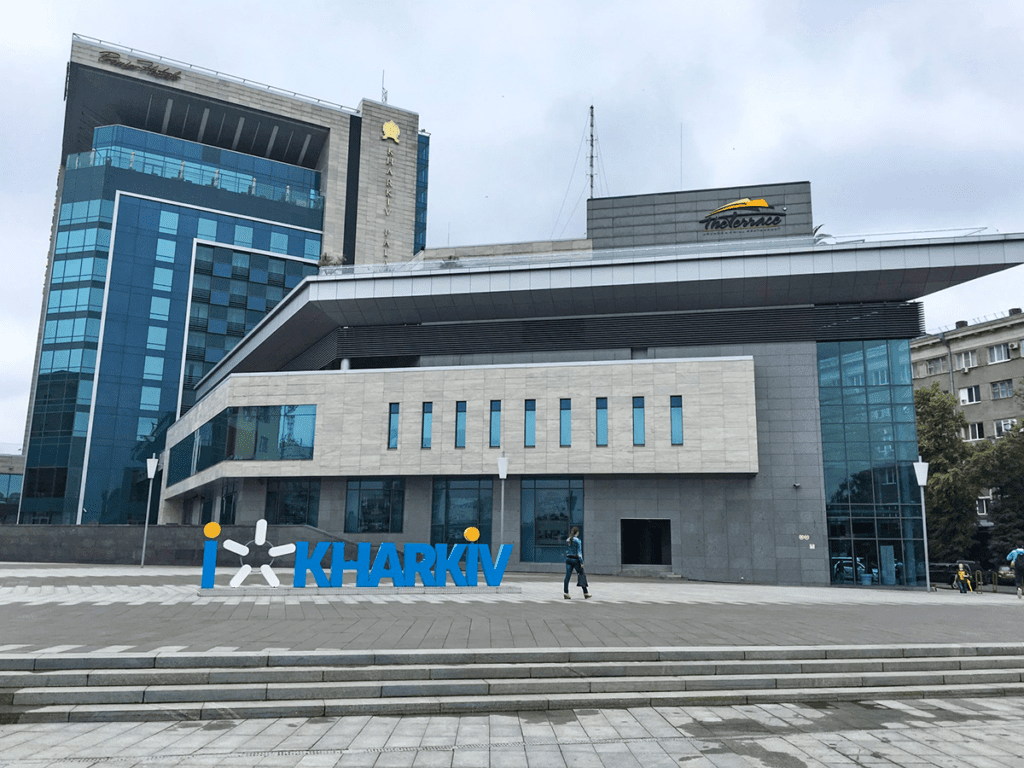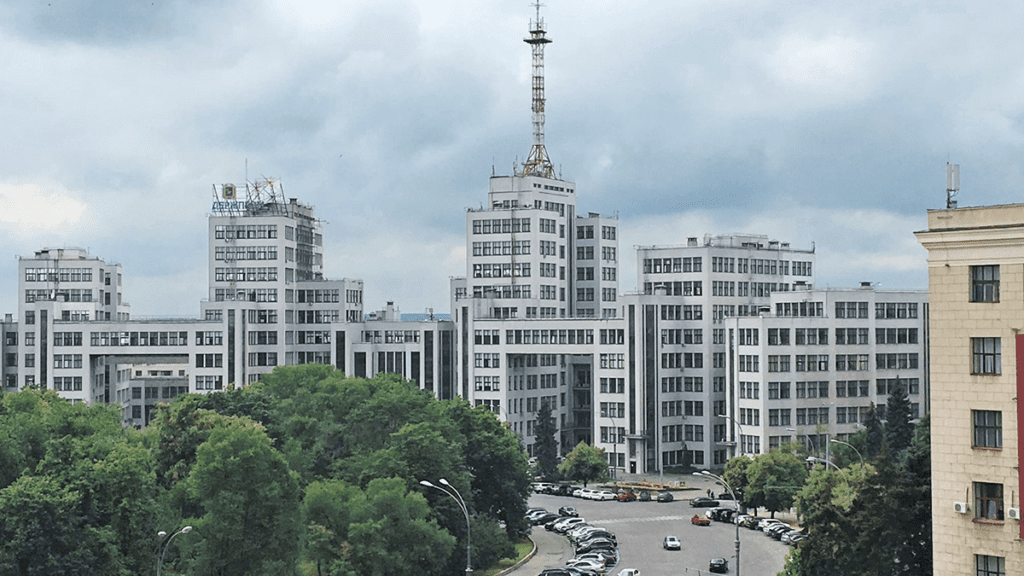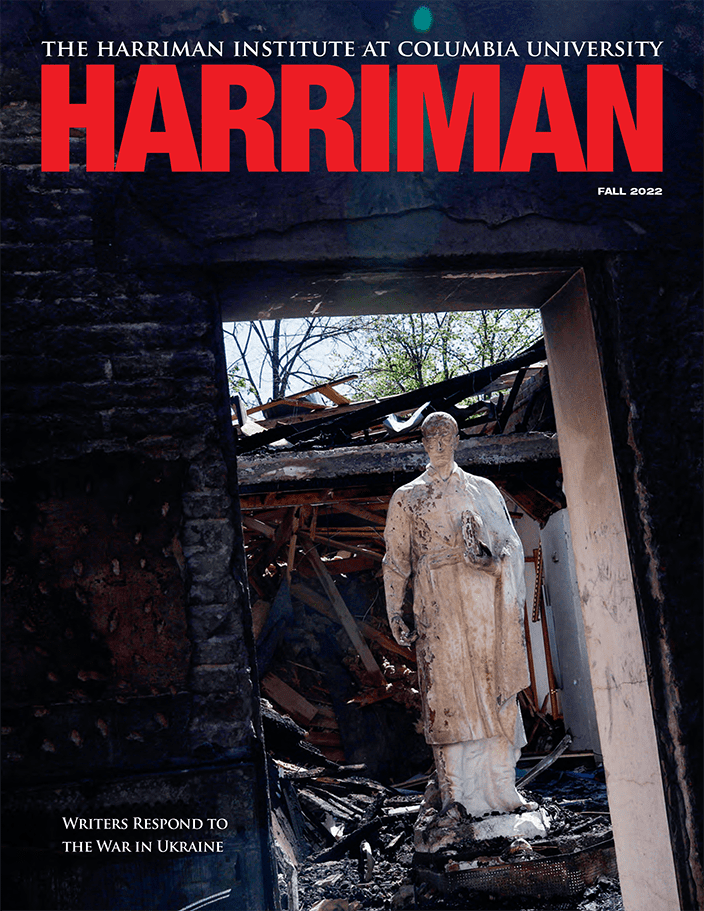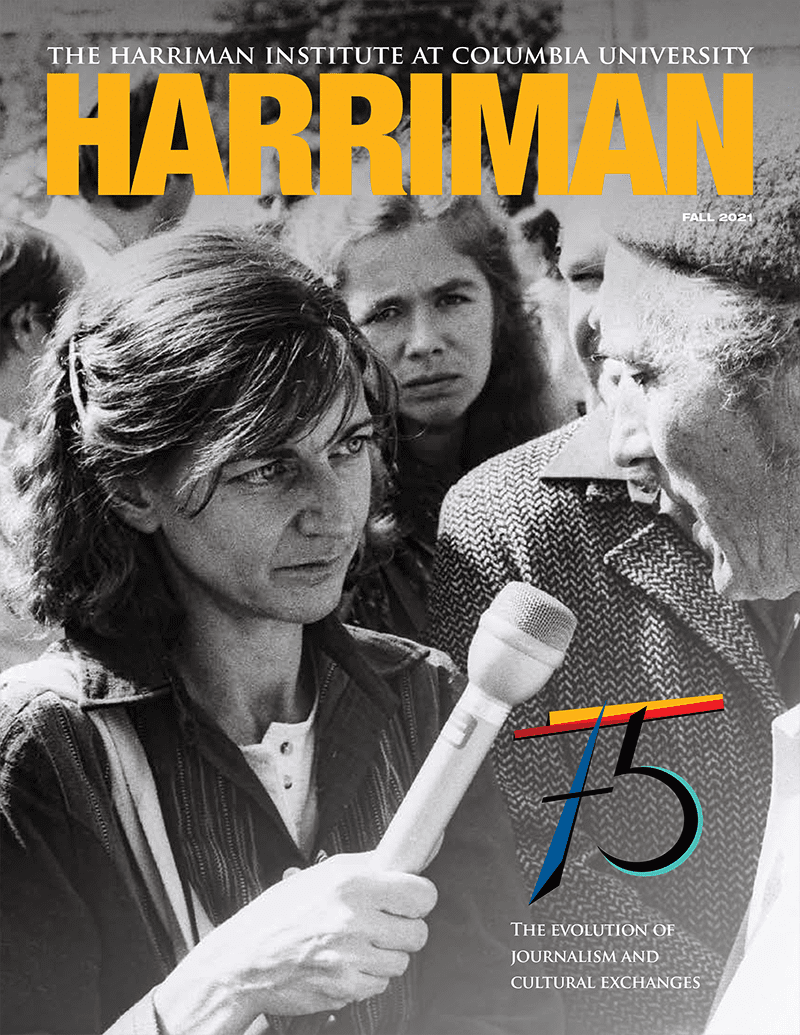Unpacking the myth of “two Ukraines” in the aftermath of Euromaidan, Crimea, and the invasion of Donbas.
In 2018 I sat on the rooftop deck of the Kharkiv Palace Hotel—built for the European soccer championship hosted by Ukraine several years earlier — conducting an interview with a local journalist. He explained that during the height of the war in Donbas he and his circle were worried that the conflict would come to Kharkiv, since the city is only about twenty miles from the border with Russia. The war had started in eastern Ukraine in 2014, and, as we sat in our comfortable, chic lounge chairs under the warm June sun, the idea that Kharkiv could be shelled seemed inconceivable, even ludicrous. I pushed aside the thought and focused instead on how generous and open my new colleagues and interlocutors in Kharkiv had been during my field research visits. Thinking back to that day, it still feels unfathomable that just a few years later, Kharkiv would become a major focal point of Russia’s ruthless full-scale invasion.

Palace Hotel Kharkiv where the author would stay during her research visits to the city (2018).
I had decided to conduct research in Kharkiv in order to understand the shape of public opinion in eastern Ukraine resulting from the momentous developments of 2013 and 2014: the Euromaidan Revolution that ousted pro-Russian leader Viktor Yanukovych; Russia’s annexation of Crimea; the formation of the self-styled, pro-Russian Donetsk and Luhansk “Peoples’ Republics;” and the war in Donbas. The conventional wisdom explained these events as a product of “two Ukraines”: a pro-European, Ukrainian-speaking west and a pro-Russian, Russian-speaking east. In this facile view, Ukraine’s geographical and linguistic divide largely determined people’s political opinions.
“The war had started in eastern Ukraine in 2014, and, as we sat in our comfortable, chic lounge chairs under the warm June sun, the idea that Kharkiv could be shelled seemed inconceivable, even ludicrous.”
But if a person’s home region can explain their geopolitical orientation and other attitudes, we might expect that a majority of residents of the eastern Donbas region would have supported separation from Ukraine in order to join Russia. Yet only about one-third of the population living in Donbas supported pro-Russian separatism there in 2014.1 Why was that? And what were the motivations of those who wished to separate from Ukraine and unite with Russia? Was it nostalgia for the Soviet past? Russian ethnic or linguistic identity? Or was it mainly about material and pragmatic interests?
I analyzed public opinion polling and statements made by residents of Donetsk and Luhansk, and discovered that economics had been the primary driver of these sentiments.2 Many people in Donbas believed their jobs and welfare would be at stake if Ukraine joined the European Union. Many also thought that Donbas, as the industrial heart of Ukraine, was subsidizing the rest of the country without receiving much in return. In addition, people who supported separatism felt Kyiv had abandoned the east in the wake of Euromaidan, and they feared violent unrest if the region remained in Ukraine. Strikingly, these kinds of concerns were far more likely to be expressed than statements about Kyiv’s supposed discrimination against the Russian language or against ethnic Russians in Ukraine. My findings undermined not only Russian President Vladimir Putin’s propaganda about aggrieved Russophone Ukrainians, but also the common impression that Russophones and ethnic Russians form a natural constituency that supports Russia.

Derzhprom (State Industry House), Kharkiv, 2018. Built in 1928, it is the oldest skyscraper complex in Europe.
The second phase of my research examined popular opinion in Ukraine’s east and south, especially in its second largest city—Kharkiv. Kharkiv did not follow the same trajectory as the cities of Donetsk and Luhansk, which formed self-styled separatist republics. Like these cities, Kharkiv had witnessed dueling pro- and anti-Euromaidan demonstrations in February 2014. Russia had bussed in paid “activists” who, together with local street fighters, temporarily took over Kharkiv’s government administration building, just like in Donetsk and Luhansk.
Yet Kharkiv did not seek to separate from Ukraine. Why not? Political scientists who researched this question found that local elites were key. Kharkiv’s leaders and security services did not switch loyalties as their counterparts had in Donetsk and Luhansk. Instead, they arrested violent separatists and continued to support Kyiv. Yet, even with this understanding, I continued to wonder how the diversity of attitudes displayed at the dueling demonstrations was playing out in post-Euromaidan eastern Ukraine more generally. My research asked: Did the 2013–14 crisis in Ukraine trigger polarized opinions? Or did it merely lay bare an underlying polarization that has characterized Ukrainian politics since independence in 1991?
Each summer from 2016 to 2018 I traveled to Kharkiv.3 In addition to conducting interviews with journalists, academics, and representatives from NGOs and business people, I co-organized focus groups of ordinary Ukrainians with Olga Fillipova, a sociology professor at Karazin National University in Kharkiv. I had interviewed Fillipova during my first research trip to the city, and, after discovering we had a lot in common, we decided to begin joint research. The next two summers we held a series of general focus groups as well as specific focus groups composed of teachers; IT workers; university students; small entrepreneurs at Kharkiv’s outdoor Barabashova bazaar; and migrants forced from their homes in Donbas. In these sessions, we asked participants to discuss their thoughts about the economy, the war, language, and the government’s reforms and policies.
Kharkiv residents, we learned, were polarized on certain issues but united on others, including a desire to end the war in Donbas. They were committed to reintegrating the occupied territories of Donetsk and Luhansk, though not if it meant that Russia would continue to control them by proxy. These views lined up with those of a majority of Ukrainian citizens at the time. Kharkiv residents were also disturbed by political parties and leaders who seemed more concerned with lining their own pockets than with Ukraine’s future. Our respondents expressed these complaints so intensely that the 2019 landslide victory of Volodymyr Zelensky, who had campaigned on a platform of fighting corruption and ending the war in Donbas, did not surprise me in the slightest.

Kharkiv Oblast (Region) State Administration Building (2018). The building was destroyed by a Russian missile attack early on in the full-scale war.
Foreign policy and the geopolitical orientation of Ukraine are critical aspects of public opinion there. After the events of 2014, residents in the east increasingly shifted away from supporting Russia and the Customs Union (Russia’s answer to the EU) and toward Europe. A much smaller minority continued to support Russia, creating a certain degree of polarization on foreign policy after 2014. But in our focus groups, we heard people articulate two other, surprising alternative opinions: first, that Ukraine should engage with both Europe and Russia; and second, that Ukraine should engage with neither pole but remain independent both from Europe and from Russia. These opinions felt surprising because they had not been reflected by Ukrainian polls. We realized that this was because the polling agencies had framed questions about Ukraine’s geopolitical orientation only in binary terms, obscuring alternative opinions and disproportionately accentuating the polarization in Ukraine. Our focus group research picked up not only the presence of additional attitudes but also frustration with the dominant alternatives that existed at the time.
“Yet Kharkiv did not seek to separate from Ukraine. Why not? Political scientists who researched this question found that local elites were key. Kharkiv’s leaders and security services did not switch loyalties as their counterparts had in Donetsk and Luhansk.”
Russia’s invasion in February 2022 has drastically changed the situation, and it has also temporarily suspended my research. But Ukraine’s polling agencies returned to work after a brief respite following the invasion, offering a glimpse into current public opinion. They show that Ukrainians are now even more unified in their opposition to Russia: more and more people embrace Ukraine’s turn toward Europe. The polls also show that a very small minority of Ukrainians in the east and south (including in Kharkiv) continue to support Russia. However, as my research from before 2022 suggests, polling questions are likely obscuring the existence of other opinions among Ukrainians by asking questions—Would you vote for or against NATO? Should Ukraine enter the EU or the Customs Union of Russia, Belarus and Kazahkstan? — that offer only binary answers. It remains an open question whether variegated opinions toward Europe and Russia will reassert themselves after the war.
Russia’s ongoing shelling of Ukraine—most of which takes place in the east and south—prevents me from returning to talk to Ukrainians to get a real sense of how they think about the cataclysmic changes since Russia’s invasion. Also—and painfully—most of my colleagues in Kharkiv have scattered. They now live in other cities of Ukraine or in Poland, the Czech Republic, and other European countries. Olga Fillipova, with whom I worked on the focus groups, spent the first weeks of the war in an underground shelter in her building complex, then braved the onslaught of Russia’s Grad missiles in central Kharkiv to travel across Ukraine with her son, settling temporarily in Finland. She continues to work for Karazin National University, teaching and working remotely via Zoom, while continuing to help students and other Ukrainians displaced by the war.
Some of my other high profile interlocutors who worked as activists in Kharkiv before the war left the city to avoid arrest in the event of a Russian occupation. Others have remained in Kharkiv and work to support the Ukrainian military and each other. Against this new reality, I look forward to a time, hopefully in the near future, when all of my friends and colleagues—and all Ukrainians—can return safely to their homes and resume their lives. ◆
- 2014. “The Views and Opinions of South-Eastern Regions Residents of Ukraine: April 8-21.” Kyiv Institute of Sociology.
- “Who Supported Separatism in Donbas? Ethnicity and Popular Opinion at the Start of the Ukraine Crisis.” (Post-Soviet Affairs, March 2018).
- My trips were funded by Harriman Institute’s Tymkiw Ukrainian Studies Faculty Research Grant.
Featured photo (at the top): The author on Kyiv’s Maidan Nezalezhnosti (2018).
Elise Giuliano is Senior Lecturer in Political Science, Director of the MA Program at Harriman Institute, and Director of the Program on U.S.-Russian Relations.







